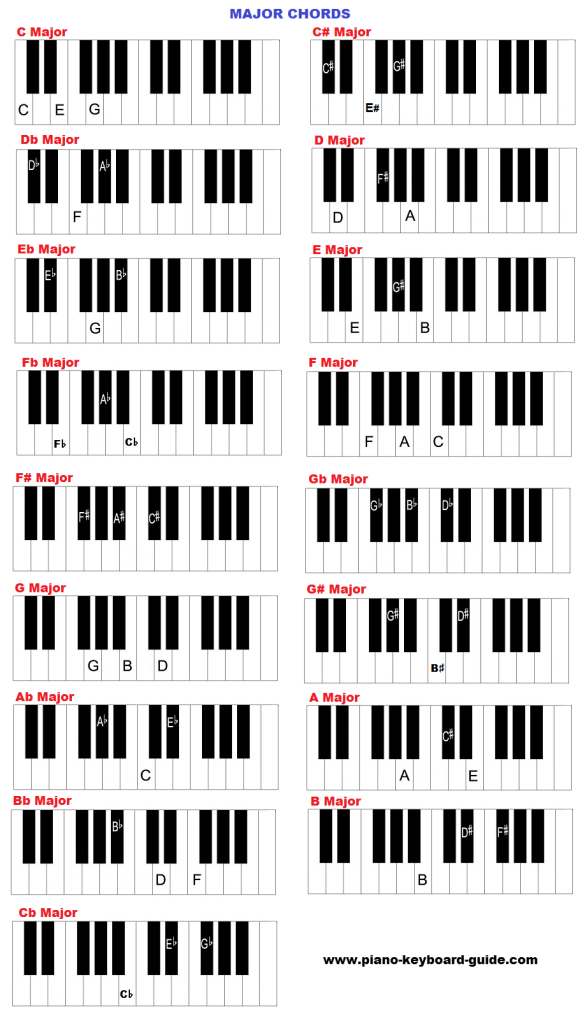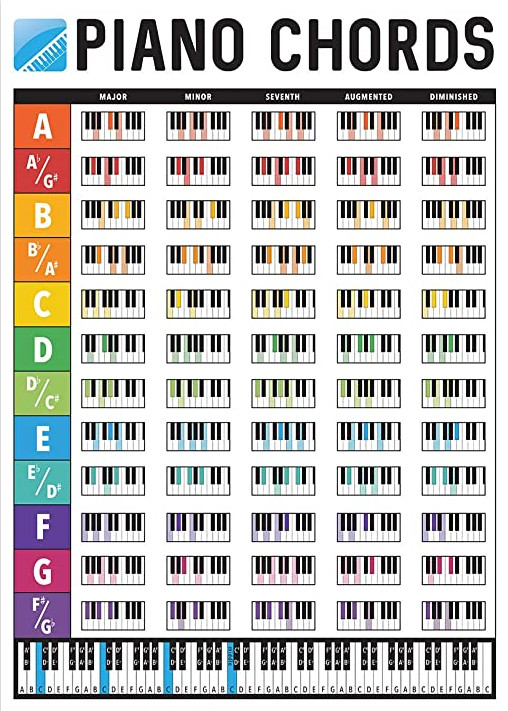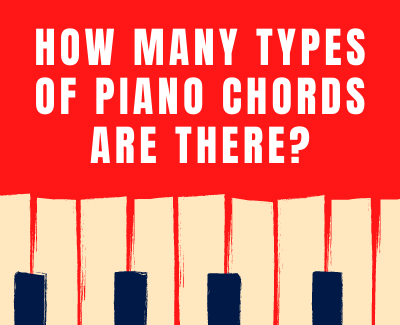There are 12 major and 12 minor chords in standard Western music, totaling 24 basic chords. Beyond this, there are augmented, diminished, and various extended chords.
Understanding the vast world of piano chords is crucial for musicians of all levels. Each chord offers a unique texture and sound, opening unlimited possibilities for creativity and expression. While the fundamental major and minor chords provide the backbone of countless songs, diving deeper into augmented, diminished, and extended chords reveals a rich tapestry of harmonic potential.
Mastering these chords equips pianists to navigate through various musical genres and styles, from classical compositions to modern pop hits. This knowledge not only enhances playing techniques but also enriches the overall understanding of music theory and composition, making it an invaluable component of musical education and practice.

Credit: www.piano-keyboard-guide.com
Diving Into The World Of Piano Chords
Piano chords open a universe of musical expression. Knowing them is key to playing songs. Imagine painting with all the colors – that’s what chords offer to music. This guide explores the endless possibilities hidden within the keys of a piano.
The Basic Building Blocks Of Music
Chords form the heart of piano music. A chord is a group of notes played simultaneously. The basic piano chords are major, minor, diminished, and augmented. These foundational shapes create countless songs. Think of them as the alphabet to the language of music.
| Type of Chord | Notes in Chord | Sound Characteristic |
|---|---|---|
| Major | Root, Major third, Perfect fifth | Bright, happy |
| Minor | Root, Minor third, Perfect fifth | Sad, somber |
| Diminished | Root, Minor third, Diminished fifth | Tense, unstable |
| Augmented | Root, Major third, Augmented fifth | Bright, suspenseful |
Variations In Chord Types
Apart from the basics, many variants exist. These variations add spice to music. They involve adding, subtracting, or altering notes. Below are examples of complex chord types:
- Seventh Chords – Add a note a seventh above the root
- Suspended Chords – Replace the third with a fourth or second
- Added Tone Chords – Add a note that is not in the chord
- Extended Chords – Add notes beyond the seventh
- Altered Chords – Sharpen or flatten certain notes
Each variation affects the mood of the music. They can create tension, resolution, or a dreamy feel. Mastering them takes practice, but it’s rewarding. It’s like adding more colors to a painter’s palette.
Classifying Piano Chords
The beauty of piano music lies in its chords. These groupings of notes create harmony and express various emotions. With the piano’s 88 keys, the possibilities seem endless. Each chord has a structure and a sound that makes it special. To understand how we classify them, let’s dive into the world of piano chords.
Major And Minor Chords
Major and minor chords form the foundation of piano music. They are the simplest and most commonly used chords.
- Major chords sound happy and bright. They are built with a root, a major third, and a perfect fifth.
- Minor chords have a more sad and emotional tone. They use a root, a minor third, and a perfect fifth.
Augmented And Diminished Chords
Augmented and diminished chords add tension and drama to music. They are less common but very powerful.
- Augmented chords have a root, a major third, and an augmented fifth. They sound mysterious and unresolved.
- Diminished chords are built with a root, a minor third, and a diminished fifth. They create a sense of urgency and instability.
Seventh Chords And Beyond
Seventh chords and larger chords offer more complexity in harmony. Musicians often use them in jazz, blues, and classical music.
- Seventh chords add a seventh note to the base triad, resulting in a fuller sound.
- Extended chords like ninths, elevenths, and thirteenths introduce additional layers and textures.
These chord extensions can either follow the major or minor pattern and often include alterations as well.
Numbers Game: Counting The Chords
Embarking on the journey through the world of piano chords feels like an exciting numbers game. It’s a musical maze with many paths to explore.
Calculating Chord Possibilities
When we peek into the realm of chords, it’s crucial to unfold the math behind the melodies. Think of a chord as a combination of notes played in harmony. The piano has 88 keys, but not all those keys will be used at once to create a chord. Instead, if we look at the most common types of chords, like triads (three-note chords) and seventh chords (four-note chords), we can start to uncover the potential variety.
Let’s break it down:
- Major and Minor Triads: Every key has a major and a minor chord.
- Seventh Chords: These add another layer of complexity and emotion.
- Suspended and Added Tone Chords: These introduce a different sound.
Doing the math, even with just these types of chords, quickly multiplies the possibilities into the hundreds.
The Role Of Enharmonics
Enharmonics add a twist to our chord count. These are notes that sound the same but are written differently, like C# and Db. Because of enharmonics, a single chord can have multiple names. This means the number of unique chords is actually less than you might think!
Consider these examples:
| Enharmonic Chord | Different Names |
|---|---|
| C# Major | Db Major |
| F# Minor | Gb Minor |
The role of enharmonics shows us that while the list of chord names might be long, the actual number of unique sounds is fewer.

Credit: www.musictoyourhome.com
Practical Limitations On Piano Chords
Think of piano chords as a vast universe. They float in a space with borders. Knowing these borders helps us focus on music that sounds great. Let’s look at practical limits on piano chords.
Physical Constraints Of The Keyboard
Pianos have a set number of keys. This sets our first boundary. Imagine placing your fingers on the keys. You have ten fingers and a span that reaches only so far. Let’s break it down:
- 88 keys: Most pianos have this many.
- Key reach: Most people can stretch 8-10 keys.
- Comfort: Playing beyond your reach is tough.
Bold combos make new chords. Yet, our hands limit the chords we can play well.
Standard Chord Usage In Composition
Composers often stick to proven chords. Audiences find these pleasing. Here’s a table of common chords found in many songs:
| Chord Type | Example |
|---|---|
| Majors | C, G, D |
| Minors | Am, Em, Dm |
| Sevenths | G7, C7, E7 |
| Diminished | Cdim, Gdim, Ddim |
The list goes on, but unique, complex chords are less common. Songs usually use familiar chords. These make the music relatable and enjoyable.
Exploring Advanced Chord Structures
Welcome to the intricate world of advanced piano chord structures. Understanding the full spectrum of piano chords empowers pianists to enrich their musical expression. This journey delves deep into complex harmonies that intrigue both the player and listener.
Chord Extensions And Alterations
Chord extensions and alterations push beyond basic triads and seventh chords. They add layers of depth to a piece. Here’s how they work:
- Extensions – Add notes beyond the octave, creating 9ths, 11ths, and 13ths.
- Alterations – Sharpen or flatten certain notes within the chord for unique sounds.
Extensions and alterations are the spices of the chord world. They transform standard harmonies into nuanced flavors. They often appear in genres that value complex harmonies, such as jazz and progressive rock.
The Use Of Jazz And Pop Chords
Jazz and pop music often use advanced chords. These chords give these genres their distinctive sound. Let’s break down their use:
- Jazz chords frequently feature sevenths, ninths, elevenths, and thirteenths.
- Pop music tends to simplify jazz chords, but still employs sixths and added tone chords.
Both genres play with chord structures to create memorable progressions. Recognizing these chords can uplift your performance and songwriting skills.

Credit: www.learncolorpiano.com
Learning And Mastering Chord Progressions
Learning and mastering chord progressions can unlock the secrets of your favorite songs. These sequences of chords breathe life into music. They create the backbone of melodies and harmonies. As a pianist, you get to explore countless chord combinations. Each combination tells a different musical story. Are you ready to dive into the exciting world of chord progressions?
Effective Practice Techniques
The path to chord progression mastery begins with effective practice. How do you ensure your practice sessions lead to real improvements? Here are some tips:
- Start Slow: Learn each chord shape and transition without rushing.
- Use a Metronome: Keep your timing consistent and gradually increase the tempo.
- Break It Down: Tackle complex progressions by splitting them into smaller parts.
- Practice in Different Keys: This builds flexibility and understanding of music theory.
- Play Along with Songs: Apply progressions by playing alongside your favorite tracks.
Progressions That Define Musical Styles
Chord progressions are the signatures of various musical styles. From jazz to pop, each genre has its own set of commonly used progressions. Recognizing these can enhance your ability to play across genres. Below is a table showcasing different progressions and the styles they are associated with:
| Progression | Musical Style |
|---|---|
| I-IV-V | Blues, Rock’n’Roll |
| ii-V-I | Jazz, Bossa Nova |
| I-vi-IV-V | 50s progression, Doo-wop |
| I-V-vi-IV | Pop, Modern Rock |
Are the Piano Chords for “Can I Be Him” included in the Total Count of Piano Chords?
Yes, the piano chords for “Can I Be Him” are included in the total count of piano chords. You can easily find the can i be him piano chords online to practice and play the song on the piano.
Frequently Asked Questions On How Many Piano Chords Are There
How Many Total Chords On Piano?
A piano has a total of 88 keys, but the number of chords you can play is technically infinite due to the combination of notes possible.
What Are All 12 Piano Chords?
The 12 primary piano chords are C, C#, D, D#, E, F, F#, G, G#, A, A#, and B. Each can be played as major or minor.
Are There 24 Chords In Piano?
Yes, there are far more than 24 chords on the piano. Chords are combinations of three or more notes, and with 88 keys, the piano can produce a vast array of chords in various positions and inversions.
How Many Chords Do You Need To Know To Play Piano?
To play the piano, it’s useful to know at least the 12 major and 12 minor chords. Mastery of these 24 chords can help you play many songs.
Conclusion
Exploring the vast landscape of piano chords can be both exhilarating and daunting. Yet, armed with knowledge and practice, mastery is within reach. Whether you’re a budding musician or a seasoned pianist, the journey through these harmonic building blocks is endless.
Embrace the challenge, and let your creativity flourish on the keys.
